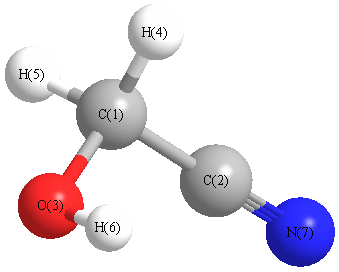Jump to
S1C2
Vibrational Frequencies calculated at QCISD(T)/cc-pVTZ
Geometric Data calculated at QCISD(T)/cc-pVTZ
Electronic energy levels
Charges, Dipole, Quadrupole and Polarizability
Jump to
S1C1
Energy calculated at QCISD(T)/cc-pVTZ
| | hartrees |
|---|
| Energy at 0K | -207.641697 |
| Energy at 298.15K | -207.645018 |
| HF Energy | -206.845653 |
| Nuclear repulsion energy | 101.879355 |
The energy at 298.15K was derived from the energy at 0K
and an integrated heat capacity that used the calculated vibrational frequencies.
Vibrational Frequencies calculated at QCISD(T)/cc-pVTZ
| Mode Number |
Symmetry |
Frequency
(cm-1) |
Scaled Frequency
(cm-1) |
IR Intensities
(km mol-1) |
Raman Act
(Å4/u) |
Dep P |
Dep U |
|---|
| 1 |
A |
3839 |
3642 |
|
|
|
|
| 2 |
A |
3126 |
2965 |
|
|
|
|
| 3 |
A |
3049 |
2892 |
|
|
|
|
| 4 |
A |
2278 |
2160 |
|
|
|
|
| 5 |
A |
1501 |
1424 |
|
|
|
|
| 6 |
A |
1427 |
1354 |
|
|
|
|
| 7 |
A |
1384 |
1313 |
|
|
|
|
| 8 |
A |
1236 |
1172 |
|
|
|
|
| 9 |
A |
1095 |
1038 |
|
|
|
|
| 10 |
A |
993 |
942 |
|
|
|
|
| 11 |
A |
894 |
848 |
|
|
|
|
| 12 |
A |
571 |
542 |
|
|
|
|
| 13 |
A |
370 |
351 |
|
|
|
|
| 14 |
A |
295 |
280 |
|
|
|
|
| 15 |
A |
210 |
199 |
|
|
|
|
Unscaled Zero Point Vibrational Energy (zpe) 11133.1 cm
-1
Scaled (by 0.9486) Zero Point Vibrational Energy (zpe) 10560.9 cm
-1
See section
III.C.1 List or set vibrational scaling factors
to change the scale factors used here.
See section
III.C.2
Calculate a vibrational scaling factor for a given set of molecules
to determine the least squares best scaling factor.
Geometric Data calculated at QCISD(T)/cc-pVTZ
Point Group is C1
Cartesians (Å)
| Atom |
x (Å) |
y (Å) |
z (Å) |
|---|
| C1 |
-0.577 |
0.592 |
0.038 |
| C2 |
0.825 |
0.114 |
-0.006 |
| O3 |
-1.512 |
-0.455 |
-0.110 |
| H4 |
-0.714 |
1.151 |
0.968 |
| H5 |
-0.734 |
1.276 |
-0.794 |
| H6 |
-1.391 |
-1.068 |
0.621 |
| N7 |
1.920 |
-0.279 |
-0.015 |
Atom - Atom Distances (Å)
| |
C1 |
C2 |
O3 |
H4 |
H5 |
H6 |
N7 |
| C1 | | 1.4819 | 1.4117 | 1.0940 | 1.0891 | 1.9388 | 2.6449 |
C2 | 1.4819 | | 2.4079 | 2.0969 | 2.0985 | 2.5891 | 1.1633 | O3 | 1.4117 | 2.4079 | | 2.0928 | 2.0173 | 0.9619 | 3.4382 | H4 | 1.0940 | 2.0969 | 2.0928 | | 1.7672 | 2.3463 | 3.1548 | H5 | 1.0891 | 2.0985 | 2.0173 | 1.7672 | | 2.8161 | 3.1736 | H6 | 1.9388 | 2.5891 | 0.9619 | 2.3463 | 2.8161 | | 3.4631 | N7 | 2.6449 | 1.1633 | 3.4382 | 3.1548 | 3.1736 | 3.4631 | |
 More geometry information
More geometry information
Calculated Bond Angles
| atom1 |
atom2 |
atom3 |
angle |
|
atom1 |
atom2 |
atom3 |
angle |
| C1 |
C2 |
N7 |
178.403 |
|
C1 |
O3 |
H6 |
108.029 |
| C2 |
C1 |
O3 |
112.612 |
|
C2 |
C1 |
H4 |
108.038 |
| C2 |
C1 |
H5 |
108.447 |
|
O3 |
C1 |
H4 |
112.656 |
| O3 |
C1 |
H5 |
106.833 |
|
H4 |
C1 |
H5 |
108.089 |
Electronic energy levels
Charges, Dipole, Quadrupole and Polarizability
